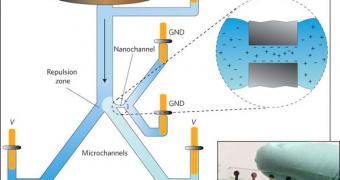Scientists from the Massachusetts Institute of Technology (MIT), in Cambridge, have recently announced the development of a new type of microfluidic device that is capable of extracting the salt out of sea water. The innovation allows for scientists to produce about one glass of water each hour, using only about the same amount of energy as a table lamp. The main advantage that the new technology, called ion channel polarization, has over the regularly-used reverse osmosis process is that it is portable, as it relies on components that operate at a very small scale, ScienceNow reports.
At this point, water desalination plants exist at many locations around the globe, but all of them function on reverse osmosis. In this technology, large amounts of pressure are used to drive the salt ions through a porous membrane, and therefore obtain drinkable water. But this approach has two main flaws. For starters, it cannot ensure that pollutants do not pass through the membrane, and second of all, the plants producing potable water are very large. This means that they cannot be made portable under any circumstances. Both these issues are resolved with the MIT innovation, the team says.
The approach, also known as ICP, is underlined by a fairly simple working principle. The method has been around for a while, but thus far it would appear that no one thought of it as having a potential to be used in desalination. In ICP, a liquid containing both neutral and charged ions is run through a series of small channels, whose walls are endowed with an electrical potential that repels the charged particles. This basically forces the liquid stream to separate into two distinct flows, one featuring only the charged ions, and the other the neutral ones.
“We thought, if we apply this technique to the seawater, then we can eliminate [salt] ions,” says the head of the new project, MIT postdoctoral student Sung Jae Kim. The research group was led by engineer Jongyoon Han. It was also discovered that the technique could be used to extract other charged contaminants from the water as well, including forms of pollutants and even microorganisms such as bacteria. The researchers even ran a test in which they placed blood cells into a sample of seawater before running it through ICP. The end result was as stream of liquid carrying blood cells, and one containing fresh water alone.

 14 DAY TRIAL //
14 DAY TRIAL //